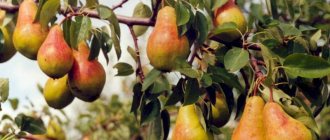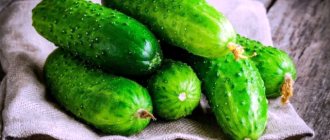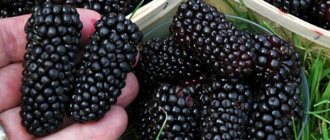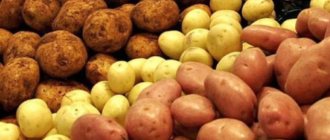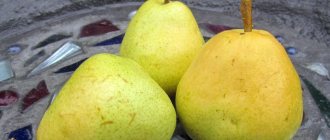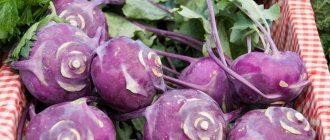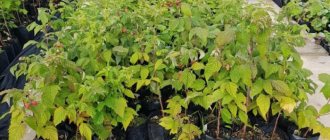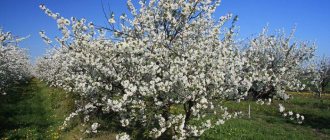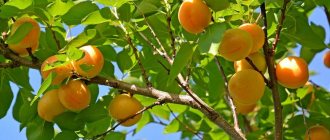Description of the pear
Pear is a fruit crop of the Rosaceae family, belongs to the dicotyledonous class, flowering division. The first pear varieties were bred by breeder Ivan Michurin. Currently, there are more than 200 varieties of pears. Among them there are many winter-hardy ones that can withstand cultivation in the Moscow region and other cold regions.
The above-ground part of the pear is more resistant to cold than the root system. But even in cases where a certain variety does not have sufficient frost resistance, gardeners have found a way out that promotes growing crops in cold areas. And this solution is to graft a pear cutting into the crown of another variety that is more frost-resistant. As a result, the pear tree consists of 2 parts, whose root system tolerates cold well, and the above-ground part of the crop produces amazingly tasty fruits.
With proper care and favorable conditions, the pear grows from 5 to 25 m in height and reaches 5 m in crown diameter. The culture blooms from April to May with white flowers reaching 3 cm in diameter. The pear fruit usually has an elongated shape with a widening at the bottom; there are varieties with spherical fruits.
The pear fruit tree grows best on fertile, loose soil that has neutral or low acidity. On very wet and acidic soils, the tree does not take root well and does not bear fruit. Typically, a pear begins to bear fruit from 4–7 years.
Pear for the Volga region and central Russia
Chizhovskaya
Winter-hardy pear Chizhovskaya
Olga and Lesnaya Krasavitsa were taken as “parent” varieties, as a result of long work by S.T. Chizhova and S.P. Potapov and the Chizhovskaya variety was developed. One of the popular self-pollinating varieties in the middle zone, especially in the Volga region and surrounding areas . The tree grows no more than 3 m, the young tree has a narrow crown, grayish tints. Older branches acquire a brownish color, the branches look upward, are medium in thickness, slightly curved. The leaves are oval-shaped, dark green in color with smooth edges.
The fruits themselves weigh no more than 150 grams. At the beginning of summer, the pear has light green tones, the fruit is quite hard, but closer to autumn they acquire yellow shades and become soft. In this condition, the Chizhovskaya pear will not hang on the tree for long, so it is recommended to pick it in early autumn. Green fruits can last for several weeks . Sweet and meaty in taste, ripen in mid-August. They have white, medium-grained pulp with a pleasant aroma. In addition, she inherited resistance to frost and disease from her “relatives”.
The peculiarity of the variety is that the older the tree, the smaller the fruits. You can combat this by timely pruning.
Lada
Lada pear belongs to the early summer varieties.
The result of crossing the Lesnaya Krasavitsa and Olga varieties, a variety suitable for planting in the middle zone. It is distinguished by the early ripening of its fruits; you can taste fresh fruits already in the middle of summer . Lada is frost-resistant, is not susceptible to diseases and pests, and produces a rich harvest every year. A tree with a branched crown, the branches are slightly drooping, looking down. The height of the tree is no more than 3 m, with a pyramidal trunk, dark gray in color. The leaves are shiny, smooth, dark green in color. It overwinters quite well even in the harshest winters, is resistant to diseases, and is partially self-fertile.
The fruits are medium-sized, no more than 100 grams , light green in color with thin skin. Closer to ripening, the fruits turn yellow and become soft to the touch. It is important to catch the moment to remove the fruits from the tree, otherwise they become soft, covered with rusty spots and fall off. The fruit is attached to the branches in pairs on short stalks. The taste is sweet, with a slight hint of sourness and can be stored for a long time when picked, especially in a cool place.
Bessemyanka
Bessemyanka pear is a high-yielding variety.
Popular and quite interesting for planting, it has especially spread in the Central regions, and also grows well in the middle zone. The tree is vigorous, has a fast growth rate, produces a stable harvest, and does not need rest. Productivity is high, more than 50 kg of fruits are harvested per year. A tree over 6 m high, with spreading and curved branches. The leaves are oval-shaped, dark green in color, with rounded edges. The variety is also resistant to frost, but is susceptible to scab and other diseases.
Every year it pleases with a large amount of harvest, although the fruits are quite small, more like apples. Light green in color, firm when ripe, the fruits turn yellow and soft when ripe. One fruit at a time on short stalks is attached to the branches. Ripening occurs at the end of summer, when the fruits acquire yellowish tints . Doesn't last long on the tree and quickly falls off. In addition, it does not last long when picked, no more than 2-3 weeks.
In Europe, until tobacco was introduced, crushed pear leaves were used for smoking.
Skorospelka from Michurinsk
Skorospelka pear from Michurinsk
This variety breaks all records for the speed of fruit ripening. Developed by I.V. Michurin as a result of crossing the Citron de Carm and Bere Ligel varieties. It belongs to the early varieties of pear; the harvest ripens by mid-summer . It is a tall tree, the shape of the trunk is pyramidal, light brown in color.
The fruits are no more than 90 grams, green in summer, acquire a yellow tint when fully ripe. Small fruits are compensated by taste: sweet, juicy, this pear is loved not only by gardeners, but by bees and birds. Therefore, it is better to collect them when they are a little hard and can be stored for no more than a week. The tree itself is winter-hardy, with a dense crown, resistant to diseases and pests.
Allegro
Pear variety for the middle zone Allegro
Developed thanks to artificial pollination of the Osennyaya Yakovleva variety. Another variety for the middle zone, which bears fruit annually, is easy to care for, and resistant to disease and severe cold. Fruiting begins at the age of 3; over time, the fruits become larger in size. The tree is medium-sized, more than 5 m high , with a drooping crown. The branches are curved, light gray in color, the leaves are slightly elongated, densely green.
A pear weighing from 120 grams with a thick skin, but juicy and sweet flesh, with a spicy aroma. Regular pear-shaped, fruits are slightly elongated. They are attached to branches using a thick stalk and grow singly on a branch. Ripening occurs at the beginning of August , the fruits turn yellowish-red and become soft. The variety is not stored for long; ripe fruits hang on the tree for no more than 2 weeks, but when harvested they can last for more than a month.
Central Russia has a special climate that is not suitable for the growth of all varieties of pears. There are pronounced hot summers, harsh winters, and transition periods with high rainfall. Only those who “love” such weather can grow and bear fruit here, and proper care will ensure greater pear yields.
Useful properties of pear
Pears contain less sugar than apples, but the pear tastes sweeter. The presence of large amounts of fructose has a beneficial effect on the activity of the pancreas.
Pear is a low-calorie product; 100 g contains only 42 kcal. Therefore, it is useful for people watching their figure or on a diet.
The fruit contains:
- vitamin A;
- B vitamins;
- ascorbic acid;
- tocopherol;
- phylloquinone;
- mono- and polyunsaturated fatty acids;
- saturated fatty acids;
- phytosterol;
- selenium;
- iron;
- magnesium;
- manganese;
- sulfur;
- iodine;
- copper.
The essential oils that pear contains boost immunity, eliminate infectious and inflammatory processes, and help improve mood. Organic substances have a positive effect on digestive and metabolic processes, fiber reduces the amount of “bad” cholesterol, giving a feeling of fullness. And the high tannin content is a good remedy for diarrhea. But keep in mind that overripe or spoiled fruits can lead to stomach upset.
The plant fibers contained in the pear activate the excretion of bile. Therefore, experts recommend eating pears for liver diseases.
Planting a pear
A good and healthy pear seedling is an important component of a future bountiful harvest, of course, together with proper care. You can buy pear seedlings with delivery throughout Russia in our online store of seedlings of the peasant farm orchard. Our prices will pleasantly surprise you, and fast delivery will definitely please you!
Suitable for planting are 1-year-old and 2-year-old pear seedlings that have a well-developed root system and no damage to the above-ground parts. It is permissible to plant a pear in the spring, but we recommend doing it in the fall (mid- or late September), when the leaves of the tree have fallen and sap flow has slowed down. The seating area should be well lit and protected from winds.
The planting hole should be 80 cm deep and a meter wide. Drive a stake at a distance of 30 cm from the center of the hole; it will be needed for proper growth of the crop. Keep in mind that the seat must be dug in advance.
Add 10 kg of rotted compost, 2 and a half tbsp. superphosphates and 6 tsp. potassium salt. Mix these substances with a small amount of soil.
After all the activities were completed, it was time to plant the seedling. Place the pear tree in the middle of the hole, spread the roots along the ground and begin to dig in little by little. The root collar should be 8 cm above the ground level. After this, compact the soil and water the seedling with 2 buckets of water. Tie the pear trunk to a peg, then mulch the circle around the trunk with humus.
In memory of Zhegalov
The best varieties of pear include “In Memory of Zhegalov” . This is a late-autumn variety that is resistant to cold and disease. The fruits are medium-sized, weighing up to 130 grams, doubly conical in shape, greenish-yellow in color. The pulp is light yellow, sometimes whitish, juicy, with a rich aroma.
Since the variety is self-sterile, it needs the selection of pollinating varieties. This is his only drawback.
5 0
Pear care in autumn and spring
In the fall, it is necessary to carry out the following pear care activities:
- sanitary pruning of branches;
- fertilizing with phosphorus fertilizers;
- preventive treatment against pests and diseases;
- whitewashing the tree trunk with lime;
- deep watering of the tree trunk area and digging;
- covering the tree trunk area with a 20 cm layer of sawdust.
In the spring, pear care comes down to removing covers and repeating autumn care measures using nitrogen fertilizers instead of phosphorus fertilizers.
Autumn Yakovleva
“Osennyaya Yakovleva” is one of the most popular pear varieties suitable for cultivation in central Russia. The harvest can be harvested at the end of August. The fruits are medium-sized, rounded-rhombic in shape. The pulp is juicy, tender, but slightly aromatic.
The variety is valued for its stable high yield and excellent taste. The advantages of the variety include good winter hardiness and high drought resistance. Unfortunately, “Osennyaya Yakovleva” is easily affected by scab - this is the main drawback of the variety.
Classification of pears
By ripening time:
- summer (early);
- autumn (middle);
- winter (late).
By fruit size:
- small;
- average;
- large.
By method of use:
- decorative culture;
- fruit crop.
For winter hardiness:
- winter-hardy;
- not winter-hardy.
By height:
- dwarf;
- short;
- medium height;
- tall.
By pollination method:
- self-fertile;
- not self-pollinating.
Early varieties of pears ripen in late July or early August; in cold regions, harvesting occurs in early September. Such varieties should be collected in a timely manner, as overripening or shedding is not allowed. Depending on the variety, such pears are stored in a cool place for 7–17 days.
Harvesting of medium varieties of pears occurs in late September-early October. Ripe fruits must be collected as quickly as possible. Autumn pear varieties can be stored in a cool place for 45–70 days. Most autumn pear varieties have good frost resistance and are suitable for growing in the Moscow region. These are the varieties:
- Muscovite;
- Conference;
- Simply Maria;
- Fun;
- Yakovlev's favorite.
Late pear varieties enter ripeness in mid-October, and fully ripen during storage. For this reason, such varieties are mainly grown in regions with mild climates. At a temperature of 3 to 5 degrees Celsius, the fruits can be stored until January or April of next year.
How to select and store?
Here you need to rely on your sense of smell and tactile sensations. A sufficiently ripe and sweet pear is very aromatic, and it emits a rather pleasant, sweet smell.
Also, when choosing a good pear, you need to carefully examine the appearance of the fruit. The skin should be painted in a uniform shade, with a smooth surface on which there should be no dents, cracks or signs of rot or mold.
In addition, a quality fruit will always have firm fruit. If the pear feels soft to the touch, it means the fruit is overripe. So, we figured out how to choose a pear. Now you need to understand how to properly store a pear so that it does not spoil ahead of time.
Where can you store pears?
The room must be chosen sufficiently dark and cool. To do this, you can use the balcony, cellar, basement and refrigerator. This type of fruit cannot be frozen.
How to store pears at home?
For any storage method, you need to use only those fruits that are not damaged and are not yet fully ripe (just starting to turn yellow). The container where the fruit will be placed must have a smooth surface, some soft material must be laid on the bottom, and the walls of the container must be covered with paper. When the container is prepared, you should start preparing the fruits themselves. Each pear needs to be wrapped in thin and soft paper and folded into a container in three layers. It is also necessary to cover each layer with paper. The fruits must be placed diagonally in the container so that the stalks do not touch each other.
How to store pears in an apartment?
As already mentioned, the place should be dark and cool, so a balcony and a refrigerator are best for storage. But each type of fruit has its own specific expiration date. Summer pear varieties should be stored in the refrigerator for no more than two weeks. During this period, the fruits must either be eaten or preserved. Autumn varieties should be harvested within a week of fruit ripening. Otherwise, the fruit will lose its appearance and taste. Stored in the refrigerator or on the balcony for about forty-five days.
How to store late pear?
Winter varieties are harvested at the end of autumn (it is best to pick the fruits slightly unripe) and can be stored at home until the arrival of the spring months. At what temperature should pears be stored? The most favorable temperature is from zero to two degrees Celsius.
When storing pears at home, you need to constantly inspect the fruits. If one pear has spoiled (darkened, cracked or started to rot), it must be immediately removed from all the others.
When storing fruits in the refrigerator, you should keep the fruits separate from other foods, because the pear can absorb foreign odors.
The best pear varieties
The pear varieties presented below are ideal for growing in the Moscow region and other regions of the country.
Lada
Summer pear variety Lada, which tolerates cold well and is resistant to drought and fungal infection. This is a medium-sized tree with a pyramidal crown, the weight of one fruit is 0.1–0.15 kg. It begins to bear fruit 3–4 years after planting. Gives a good and stable harvest, resistant to scab.
Prominent
A late summer variety, its fruits ripen by early September. It tolerates frost well and has excellent resistance to fungal infections. Due to the uneven surface of the fruit, this variety of pear received another name - lumpy. It begins to bear fruit in the 5th year, but the fruits do not ripen at the same time; the harvest has to be harvested in several stages.
Chizhovskaya
A late summer variety characterized by good resistance to frost and some diseases. The Chizhovskaya pear reaches a height of 3 m, begins to bear fruit from the age of 4, and produces a stable and abundant harvest.
Chizhovskaya is a self-fertile variety, so other varieties of pears should be planted next to it. The Lada pear variety will be an ideal neighbor.
Tenderness
A wonderful and frost-resistant variety, its fruits can be stored for a long time at a temperature of 0 degrees. This variety was developed by crossing Tema and Clapp's Favorite.
Tenderness is a variety of tall tree whose fruits ripen by early September. In the 3rd–4th year of fruiting, the weight of one fruit is 0.2 kg.
Cathedral
This is a popular pear variety for growing in the Moscow region. The fruits ripen in early August, the weight of one pear is 0.1 kg. Benefits of Cathedral Pear:
- frost resistance;
- rapid ripening;
- good transportability;
- good storage;
- resistance to fungal infections;
- annual harvest.
Muscovite
An early autumn pear variety, the fruits of which do not fall off the tree when the harvest is abundant, and are well stored and transported. Muscovite is a low tree with powerful skeletal branches. The fruits of the Moskvich pear ripen quickly and are suitable for wholesale sale.
Yakovlev's favorite
It begins to bear fruit in 5–6 years, the yield increases every year. Harvest occurs in mid-September.
Fabulous
This variety is a tall tree, the weight of one fruit is 0.25 kg. After harvesting, the fruits are stored for 14 days.
Fabulous is ideal for making purees and fresh juices. Its main advantages are early ripening, suitability for commercial sale, and the ability to quickly recover after slight freezing. The crop is also resistant to gall mite and scab.
Late
Dessert Rossoshanskaya late
Rossoshanskaya is a pear with fruits of autumn ripening.
It belongs to the late varieties, the fruits ripen at the beginning of September. Dessert pear is stored until January under the correct storage conditions . The hybrid, the result of crossing the varieties Lyubimitsa Klappa and Tonkovetka, was bred in 1952. The tree is vigorous, its height is more than 6 m, the seedling has a narrow pyramidal trunk shape, gray in color, the adult tree forms a wide and smooth trunk. The crown of the pear tree is branched, the young branches are gray and look up.
The fruit is quite large, weighing up to 180 grams , dark green in color at the beginning of ripening and brown-red in autumn. They are attached to branches of 6 pieces on thick stalks. Harvesting begins in the 3rd – 4th year, the yield percentage is high. It tastes sweet, with soft skin and juicy flesh.
Belarusian
Late Belorussian pear
Bred in Belarus. The variety is late, ripening occurs in early September. The tree is small, no more than 3.5 m in height , the branches look straight up, the crown is gray-brown in color, smooth. The leaves are light green in color, oblong in shape, with jagged edges. Flowering occurs at the beginning of spring, the inflorescences are white, with a pleasant aroma.
The fruits are dull, light green in color, changing to orange-red shades during the summer. The skin of the pear is rough, quite dense, with small black spots. The stalks are short, and the pear branches are clustered in pairs. The taste of the pear is fleshy, with white pulp, juicy, and has a slight sourness . The pear is winter-hardy and is not susceptible to pests and diseases. The downside is that it doesn’t bear fruit every year and needs rest.
The Belorusskaya variety is not always able to pollinate on its own, therefore, in order to have a successful harvest, it is recommended to plant additional pollinated varieties on the site, for example, Conference or Bere Loshitskaya.
Olivier de Serres
Olivier de Serres
The work of a French breeder. The variety is quite capricious, requiring special conditions for growth and careful care. The tree is medium-sized, the crown is compact, the branches are directed upward. The crown is brownish in color, smooth, slightly flaky . During the summer, it forms many new branches, which reduces the yield, so it is important to remove excess branches in the fall. The leaves are shiny, dark green, round in shape.
Fruits can weigh more than 400 grams . In appearance, the fruits are small, round in shape, with thick skin. The entire fruit is covered with red spots, the surface is lumpy and uneven. The pear is sweet, with white fleshy pulp and a light pleasant aroma. The pear ripens by September and is stored collected until spring. It is resistant to diseases, but in harsh winters it needs additional shelter, otherwise the amount of harvest in the next year will be reduced.
Bere Ardanpont
Late ripening pear Bere Ardanpont
It was bred in Belgium by N. Ardanpont in 1759. This is a winter-hardy, low-growing hybrid that requires special care. It prefers to grow in the sun, heat and well-moistened soil - only in these conditions the tree bears fruit. The tree is vigorous, with a dense crown of brownish-gray color . Young branches are thin, not drooping, the leaf blade is pointed, dark green in color, slightly pointed in shape. Blooms in early spring with white fragrant inflorescences.
The fruits are large, green in mid-summer and reddish in color when fully ripe in autumn. Pear with thin smooth skin. This variety is loved by gardeners because of its attractive presentation , which lasts until cold weather. The pear tastes sweet, with white, fleshy flesh. It withstands winter, but it is better to cover young seedlings.
Hera
The Hera variety is famous for its large fruits.
It also applies to winter varieties, which appeared as a result of crossing Reale Turinskaya and Daughter of the Dawn. The variety is not particularly different from others, but because of its large fruits it is loved by gardeners. One pear can weigh up to 280 grams! In addition, the fruits have light green shades, which change to reddish during ripening. They are not inferior in taste, the pears are sweet, with fine-grained cream-colored pulp. They have a delicate, slightly sour taste, with a pleasant aroma.
The tree is medium-sized, no more than 6 m high, with spreading branches, crown, brownish in color. Capable of producing a large amount of harvest annually , not demanding on conditions and care. Picked fruits can be stored for several months. In addition, the variety is quite resistant to diseases, is not afraid of insects, and is frost-resistant.
In ancient Greece, pear fruit was used as a remedy for nausea.
Miraculous
Wonderful pear
Another winter pear, a hybrid obtained by crossing the varieties Daughter of the Dawn and Talgar Beauty. Has excellent resistance to frost and disease . It has a pyramidal crown shape, no more than 5 m high. The branches are thin, look upward, gray-brown in color. The leaves are round in shape, dark green in color, with small light veins clearly visible. Blooms in early spring with white fragrant inflorescences.
A high-yielding variety, weighing one fruit from 140 to 210 grams , can remain on the tree for a long time and is stored for a long time when collected. The fruits are light green, become yellowish closer to autumn, and are slightly elongated. Sweet to taste, with fleshy pulp, they have a delicate pleasant aroma.
Other pear varieties
Below are other pear varieties that are suitable for cultivation both in the southern regions and other regions of the country.
Abbot Fetel
A pear variety with average winter hardiness; in severe frosts it freezes. It is best to grow the Abbot Fetel tree in the southern regions. This medium-height tree has a dense pyramidal crown. Harvesting occurs at the beginning of September; the weight of one fruit is approximately 0.25 kg. Begins to bear fruit at 4 years of age.
Bere Bosc
This pear variety was developed at the end of the 18th century near Apremont (France). With proper care, the tree grows tall with an impressive crown. The weight of one fruit is 0.18–0.25 kg. Harvesting occurs between September 5-15, and the fruits do not ripen simultaneously. Bere Bosk begins to bear fruit in 6–7 years.
Winter hardiness is quite low even for the Krasnodar region, except for the Black Sea coast and foothills.
Bere Klerzho
The Bere Klerzho pear variety is mainly cultivated in Dagestan, Krasnodar Territory and Crimea. With proper care, the pear grows vigorously with an asymmetrical, highly pyramidal crown.
Williams
There are several subspecies of this pear variety:
- Williams Summer:
- Williams Winter;
- Williams Red.
The Williams Summer pear reaches a height of 3 m. It begins to bear fruit in the 6th year, the fruits ripen at the end of August. The average weight of the fruit is 0.15 kg, while young trees for several years in a row can produce fruits up to 200 g. The advantages of this variety include rapid fruit ripening, abundant harvest and excellent taste. Disadvantages include low winter hardiness and poor resistance to some diseases.
Williams Winter (Cure) is a tall tree with a dense crown. It begins to bear fruit in the 5th year with large fruits (up to 0.25 kg) of slightly oblong shape.
Williams Red (Rouge Delbara) is a low-growing tree with a sparse crown. This crop has average resistance to low temperatures. It begins to bear fruit in the 5th year, the fruits ripen at the end of August. The harvest can be stored for up to 60 days. The main advantage of this variety is its high frost resistance and drought resistance.
Duchess
This culture is quite unpretentious and can grow in any soil. But it produces high yields only on fertile and moderately moist soils. The tree is highly resistant to scab.
Duchess pears are harvested in mid-August; the weight of one fruit is 0.16–0.19 kg. At a temperature of 1–5 degrees, the fruits retain their taste for 1–1.5 months.
Krasnodar summer
This is a variety of medium-sized tree with a pyramidal crown of medium density.
The Krasnodar summer pear begins to bear fruit at 6–7 years, the fruits are harvested from August 10 to 20, their shelf life is 2 weeks. Tolerates drought and cold well.
Leuven
This is a winter variety of pear; the fruits must be harvested at the end of September or beginning of October. Consumer ripeness occurs in December; the fruits themselves can be stored in the refrigerator until January-February.
The fruits of the Leven pear are quite large (up to 0.22 kg); on young trees, the weight of one fruit reaches 0.4 kg. The variety tolerates drought and frost well. Damage to scab up to 1 point.
Forest beauty
This is a dessert variety of pears, its height does not exceed 5 m. Maximum growth is observed in the first 8 years, after which it slows down.
The forest beauty withstands cold weather and grows in regions where temperatures drop to minus 50 degrees. It begins to bear fruit at 6–7 years with fruits weighing 0.15–0.17 kg. Among the disadvantages, it should be noted the short shelf life of the crop and crumbling in case of overripeness.
Clapp's Favorite
This is a summer pear variety developed in America in 1860. It is a medium-sized tree, the height of which does not exceed 4 m. The fruits ripen in early August, the weight of one fruit is 0.25 kg. A special feature of this variety is that the weight of the fruit decreases by half as the tree matures.
Mature ones do not hold on to branches well and often fall off. Therefore, it is recommended to start harvesting 10 days before full ripening. Clapp's favorite begins to bear fruit in the 8th year after planting.
Moldavian early
A summer pear variety bred by crossing Williams and Clapp's Favorite.
Early Moldavian is a tall tree with a compact crown. The weight of one fruit is 0.15 kg. With a quince rootstock, the tree begins to bear fruit in 3–4 years. It tolerates cold well and can be grown in the Moscow region.
Marble
This is a variety of low tree, reaching a height of 4 m. It has a not very dense crown, reminiscent of a wide pyramid. With good yield, up to 200 kg of fruit can be collected from one tree in 1 season.
Marble pear begins to bear fruit from mid-August to early September. This crop is best grown in warm climates. Marble has poor frost resistance, so it is undesirable to grow it in regions with changeable and cold climates.
As a rule, the weight of one fruit is 0.13–0.17 kg, but sometimes fruits weighing up to 0.2 kg are found. Among the advantages of the variety are good resistance to powdery mildew, fruit rot and high yield. Among the disadvantages - Mramornaya does not tolerate cold and drought well, it begins to bear fruit from 6–7 years.
Talgar beauty
This is a medium-sized tree, reaching a height of 3 m, with a wide and dense crown. The fruits are quite large, their weight reaches 0.16–0.25 kg. The fruits ripen in late September or early October. They can be stored for several months.
The pear of the Talgar beauty variety begins to bear fruit in 4–5 years, the harvest is plentiful. This variety tolerates drought and cold easily and is suitable for growing in the Moscow region.
Japanese
This pear variety is also known as Nihonnashi.
The Japanese pear can withstand cold temperatures down to minus 30 degrees; it can be grown in the Moscow region. The appearance of pears resembles apples, and from a distance they can easily be confused with oranges.
The tree begins to bear fruit in 5–6 years; from one tree you can get a harvest of up to 80 kg. As the tree matures, its yield increases.
How to make pears ripen at home?
How to make pears ripen at home? Fruits should be picked from the tree when the skin of the fruit has just begun to turn yellow or red. Afterwards, unripe pears must be stored for about five days in a relatively cool room, where the air temperature will reach about twenty degrees Celsius. During this period, the fruits should be inspected twice a day. If some pears have not yet ripened to the end, then they need to be taken to a cooler place, where the thermometer will show five degrees Celsius.
In order for pears to ripen faster, the fruits should be kept in the refrigerator for a day, and then stored at room temperature for several days. In this way, pears can ripen much faster.
How else can you store pears so that they ripen quickly? For example, some gardeners recommend putting pears, apples and bananas in a single paper bag. A special substance (ethylene) released by the last two fruits allows pear fruits to finally ripen in a short time.
Video
Where to buy pear seedlings?
You can buy pear seedlings by mail in our online seedling store KFK Fruit Garden.
By purchasing seedlings in our online seedling store, you can be sure of their quality. With proper care, our seedlings grow into strong and healthy trees that produce high yields.
Placing an order is quite simple. Go to the Store, select the Fruit Trees and Pears section. Place the required variety and quantity into the cart, then place your order. Our specialists will contact you to confirm your order.
We know how much you love nice gifts! Therefore, as a bonus, we are giving a free consultation on the care and cultivation of pears.
If you place an order over 5–10 thousand rubles, you will receive a nice discount! Don't hesitate, place your order soon!
Previous:
- Cherry - composition, beneficial properties and varieties for the Moscow region
- Quince - planting, care, pruning and varieties
- Apricot - planting and care, the best varieties
- Roses - planting, care and best varieties
- Raspberries - planting and care, the best varieties
Marble
“Marble” is one of the best autumn pear varieties. The harvest ripens by the end of summer. The fruits are medium-sized, round in shape, weighing up to 180 grams. The color of pears is greenish-yellow with an orange-red blush. The pulp is cream and yellowish in color. The taste is delicate, with a delicate pleasant aroma.
The variety has average resistance to winter. Productivity is high. “Marble” is practically not affected by scab.
